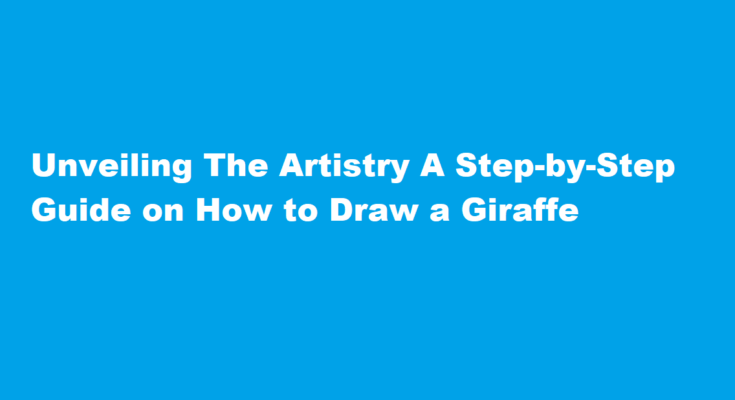Introduction
Drawing is an expressive and therapeutic form of art that allows us to bring our imagination to life on a blank canvas. If you’re looking for a subject that combines elegance and charm, a giraffe is an excellent choice. These graceful creatures with their long necks and distinctive patterns offer a captivating challenge for any aspiring artist. In this step-by-step guide, we will explore the art of drawing a giraffe, breaking down the process into manageable steps to help you create your own stunning depiction of this majestic animal.
Materials You’ll Need
Before we dive into the drawing process, gather your materials. You’ll need
1. Drawing paper or sketchbook
2. Pencils (2H, HB, 2B)
3. Eraser
4. Ruler
5. Blending tools (tortillion or blending stump)
6. Reference image of a giraffe
Basic Outline
Start by lightly sketching the basic outline of your giraffe. Use your 2H pencil to create a simple framework. Begin with a vertical line representing the giraffe’s neck, and then add a circular shape at the top for the head. Connect these with a gently curving line for the back, and sketch in the legs using elongated oval shapes. Remember that giraffes have long, graceful legs, so keep that in mind as you draw. Keep your lines light and loose at this stage, as you’ll refine them later.
Head and Neck
Focus on the giraffe’s head and neck. Using your reference image, carefully sketch the shape of the head, paying attention to the placement of the eyes, ears, and ossicones (the horn-like protrusions on the head). Giraffes have expressive eyes, so capture their essence by shaping them accordingly. The neck should be long and slender, curving gracefully. Use your HB pencil to add details and refine the features of the head.
Body and Legs
Continue working on the body and legs. Refine the shape of the body, making sure it flows smoothly from the neck. Pay attention to the details of the legs, adding joints and the distinct pattern of the giraffe’s spots. Giraffes have unique spots, so take your time to replicate them as accurately as possible. You can use your ruler to help maintain the proportions and symmetry of the legs. Gradually darken your lines to give the drawing depth.
Tail and Mane
Extend your drawing by adding the tail and the mane. Giraffes have tufts of hair on their tails and manes, which you can represent with short, textured strokes. Keep your lines loose to create a sense of movement and realism. Make sure the tail is proportional to the body and doesn’t overpower the composition. Continue to refine the overall shape of the giraffe, paying attention to any unique features you want to emphasize.
Spot Patterns
The distinctive spots of a giraffe are what make it truly captivating. Using your reference image, carefully observe the arrangement and size of the spots on your giraffe. Start adding these spots with your 2B pencil, using a series of irregular shapes and sizes to mimic the natural patterns. Be patient and take your time with this step, as achieving the right balance and randomness of the spots is essential for a realistic representation.
Shading and Texturing
To bring your giraffe to life, focus on shading and texturing. Use your blending tools, such as tortillons or blending stumps, to gently blend and smooth the pencil strokes. Pay attention to the areas where shadows fall, like the underside of the body and the legs. Giraffes have a soft, fuzzy texture, so use your pencil to create a delicate texture by adding short, fine lines or dots throughout the coat. This will give your drawing a realistic and tactile quality.
FREQUENTLY ASKED QUESTIONS
How to scare a vampire?
Garlic, Garlic, Garlic: Wear a necklace of strung garlic, which vampires despise. A hearty meal of pasta with garlic sauce and garlic bread will also help to ward them off. A garlic garland on a doorway will prevent a vampire from entering, even if he’s been invited.
Are vampires weak to fire?
And, vampires, for all their supernatural abilities, have a number of weaknesses, too. In addition to sunlight, the average vampire can be killed (or at least thwarted) by a stake through the heart, decapitation, fire, silver, garlic, the sight of a crucifix, holy water, and running water.
Conclusion
Drawing a giraffe is a rewarding artistic endeavor that allows you to capture the grace and beauty of these incredible animals. With patience, practice, and attention to detail, you can create a stunning giraffe illustration that showcases your artistic skills. Remember that art is about expression, so don’t be afraid to add your own unique touches to make your giraffe truly yours. Happy drawing!
Read Also : Crafting Digital Art Creating Collages on Your iPhone



